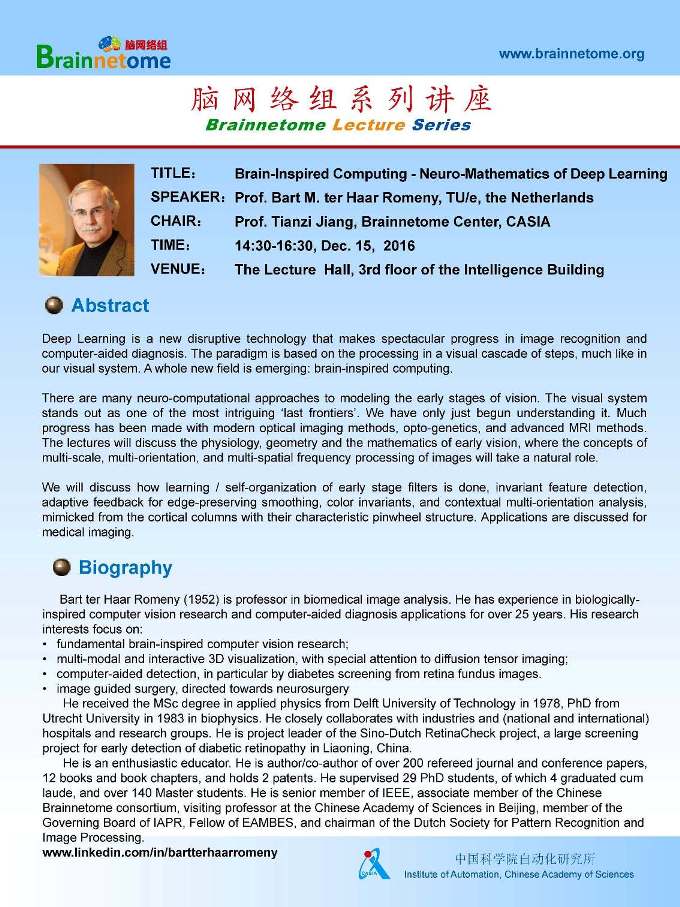Prof. Romeny's Lecture - 7T MRI investigation of the basal ganglia and development of patient-specific deep brain stimulation in Parkinson's disease
Title: 7T MRI investigation of the basal ganglia and development of patient-specific deep brain stimulation in Parkinson's disease
Speaker: Prof. Bart ter Haar Romeny, TU/e, the Netherlands
Co-author: Birgit Plantinga, TU/e.
Chair: Prof. Tianzi Jiang, Brainnetome Center, CASIA
Time: 09:00-10:00, Oct. 28, 2016
Venue: The 2nd meeting room, 13th floor of the Automation Building
[Abstract]
Parkinson's disease (PD) is a neurodegenerative disease resulting in motor symptoms such as bradykinesia, tremor, and rigidity. Degeneration of dopamine producing cells in the substantia nigra pars compacta is one of its most characteristic features. Deep brain stimulation is a widely applied treatment option. One of the challenges is to specifically stimulate the motor part of the subthalamic nucleus (STN) to prevent serious side effects. However, 1.5 T or 3 T preoperative clinical MRI scans insufficiently show the motor part of the STN. Ultra-high field MRI (7 T: 61 worldwide in 2014, and higher) gives higher resolution, signal-to-noise ratio, contrast-to-noise ratio, and/or a shorter scan time. Especially T2* and susceptibility-weighted sequences can image the iron-rich basal ganglia with high detail. The absolute T1 values of the caudate nucleus, STN, and substantia nigra, and the T2* value of the substantia nigra were decreased in PD patients compared to healthy control subjects. The caudate nucleus, substantia nigra, and internal globus pallidus displayed an altered mean diffusivity. This indicates altered iron and macromolecular concentrations and altered microstructure in these nuclei.
Diffusion-weighted MRI was employed to reconstruct the connections of the STN with the motor, associative, and limbic cortices in 17 PD patients, through a fruitful collaboration with the University of Minnesota. We could subdivide the STN into a posterolateral motor zone, an overlapping central associative zone, and an anteromedial limbic zone. Long 7 T postmortem tractography (42 hours, 7T) allowed for constructing several currently unknown connections.
[Biography]
Prof. Bart M. ter Haar Romeny is professor at Eindhoven University of Technology in the Netherlands, Biomedical Image Analysis, Department of Biomedical Engineering. He received his MSc in Applied Physics from Delft University of Technology in 1978 and PhD from Utrecht University in 1983. He was Head of Physics at the Utrecht University Hospital Radiology Department and associate professor at the Image Sciences Institute (ISI) of Utrecht University (1989-2001). He is distinguished professor at Northeastern University. His research interests focus on biologically inspired image analysis algorithms, multi-valued 3D visualization, especially brain connectivity, and computer-aided diagnosis (in particular for retinal image analysis for diabetes screening), and brain network analysis for epilepsy and neurosurgery. He is President of the Dutch Society for Pattern Recognition and Image Processing, and has been President of the Dutch Society for Biophysics & Biomedical Engineering (1998 – 2002) and the Dutch Society of Clinical Physics (NVKF, 1990-1992). He initiated the 'Scale-Space & Variational methods (SSVM)' conference series in 1997. He is reviewer for many journals and conferences, and organized several Summer Schools. He is an awarded teacher, and a frequent keynote lecturer. Prof. Romeny is Senior Member of IEEE, Board member of IAPR, registered Clinical Physicist of NVKF, associate partner and visiting professor in the Chinese Brainnetome consortium, and recipient of the Mathematica Innovation Award and the Liaoning Friendship Award.

